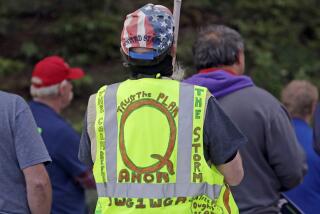Drug Plague a Racist Conspiracy? : Crack: Some blacks suspect that the white Establishment encourages or at least tolerates the epidemic of drugs and violence in black communities.
- Share via
NEW YORK — Most people would dismiss the notion as little more than paranoia but, in neighborhoods from Harlem to Anacostia to Watts, a significant number of blacks believe that the white Establishment has intentionally allowed narcotics to devastate their communities, even encouraged drug abuse as a form of genocide.
“It’s almost an accepted fact,” said Andrew Cooper, publisher of the City Sun, a Brooklyn-based black weekly. “It is a deep-seated suspicion. I believe it. I can’t open my desk drawer and say, ‘Here it is (the evidence).’ But there’s just too much money in narcotics. People really believe they are being victimized by The Man. If the government wanted to stop it, it could stop it.”
Louis Farrakhan, leader of the Nation of Islam, put it more graphically in a recent speech in Washington. He told an overflow crowd at the D.C. Armory that “the epidemic of drugs and violence in the black community stems from a calculated attempt by whites to foster black self-destruction.”
Many whites and blacks consider such statements examples of paranoia, and there is no concrete evidence to support the notion that white political leaders have actively perpetuated, or consciously tolerated, the drug scourge in the black community. But the conspiracy theory rings true to some blacks who are convinced that there must be an ominous explanation for the tragedy that has struck their community with particular force.
Pedro Noguera, a professor at UC Berkeley, said: “Whether or not there is a real conspiracy is less important than whether people believe there to be a conspiracy . . . and in the black community, they do. For years, when crack was first coming into the community, everybody knew where the crack houses were, including the police. So the police were either in on it or, if not in on it, they allowed it to exist.”
Drug abuse and drug violence effectively subjugate blacks who might otherwise vent their frustrations on whites, while also allowing powerful whites to make enormous profits from narcotics, according to this theory. Moreover, it is said that white leaders became concerned only when drugs began to claim white, middle-class victims. Many argue that the government could stem the flow of drugs if it had the political will to do so.
Such sentiments are gaining currency at a time when many blacks are disillusioned with a society in which anti-poverty and civil rights efforts have clearly flagged, some scholars say.
Beginning with the Nixon Administration, they say, many blacks became convinced that a once-protective federal government was no longer concerned with their problems, and some grew more receptive to the self-help, black-separatist rhetoric of people such as Farrakhan.
The Establishment news media, largely wedded to empirical facts, have taken only slight notice of these resurgent “conspiracy” charges.
In a recent discussion of racial issues on ABC’s “Nightline,” Brooklyn filmmaker Spike Lee said, “I think it is no mistake that a majority of the drugs in this country is being deposited in black and Hispanic and lower-income neighborhoods across the country.”
Like many of those interviewed for this article, Lee mentioned a movie scene as evidence that organized crime had targeted blacks for drug addiction.
“I remember that one scene from ‘The Godfather’ where the dons are trying to decide where the drugs are going to go, and they said, ‘Let’s give it to the (blacks); they’re animals anyway, they’re going to lose their souls.’ ”
Many black opinion leaders shy from such rhetoric.
“I don’t believe in the ‘white devil’ theory,” said Benjamin L. Hooks, executive director of the NAACP. “It’s simply the anguished cry of people who really don’t understand how it got started in the first place and why it’s out of control.”
At the same time, Hooks described the white attitude toward drug abuse among blacks as “absolute indifference bordering on criminal,” likening it to the tolerance of official segregation in the District of Columbia during the 1940s.
“White people have never been anxious to fight a problem that they perceive to be . . . an all-black problem,” he said. “It was only when it got to suburbia that it became a joint problem, a white problem, a national problem.
“If young white kids were shooting each other one a day like in the ghettos of Washington, there would be no question about taxes being raised, more policemen being hired. The people who control the money, if their sons and daughters were involved, it’d be different.”
Although most users of illegal drugs in the United States are white, hard drugs that attract violence, such as crack cocaine, are largely a problem in black communities.
Russell Adams, chairman of the Afro-American Studies Department at Howard University, called the white-conspiracy theory “a minority opinion” favored by “folks who are paranoid about other racial matters, people who see a lot of conspiracies in routine racism. They would be less educated, borderline economic and probably prone to simplistic explanations of how things happen.”
Still, variations on the conspiracy theory crop up in numerous conversations with blacks. Many say they regard the repeated federal declarations of war on drugs, including the $8-billion plan announced by President Bush, as laughable. Some of their criticisms echo those of white politicians, but the failures are frequently attributed to sinister motivations.
“There is an element that finds this a beautiful aspect of the genocidal attitude toward African American youth,” said the Rev. Lawrence Lucas, a Harlem priest known for his acerbic criticism of the white Establishment. “You’re killing them with drugs. You’re killing them with the crime connected with drugs. You send them to jail and eliminate African-American males as fathers.
“White middle-class Americans are the ones who make the money on the billions spent on law enforcement necessary to keep feeding black and Hispanic youths through the jail mill,” Lucas said. “It’s a little too coincidental not to believe this was orchestrated by a group of people for other purposes.”
Even some of those who reject such views agree with Hooks that the nation generally is unmoved by the plight of impoverished blacks.
“It’s the same old thing of benign neglect,” said Sterling Johnson, a special New York state narcotics prosecutor who is black.
“I’ve heard that this is a plot by the white Establishment to subjugate minorities, blacks and Hispanics, overtly and covertly. You’ll hear that we don’t solve the drug problem because too many higher-ups are involved.”
Publisher Cooper said the conspiracy theory was born in the 1960s, when the FBI under J. Edgar Hoover frequently targeted blacks for investigation.
“The theory was that the white Establishment pushed heroin into the black community to divert young people from political action, so they’d be zonked out and wouldn’t be a threat,” he said.
Although there are more than 500,000 cocaine and heroin addicts in New York state, treatment programs have room for only 48,000, and 6-month waiting lists are the rule at residential facilities. In many other jurisdictions, lines are longer and treatment facilities less adequate.
Such conditions fuel criticism that the federal government is not serious about reducing drug abuse.
“The addicts want treatment, and there is no treatment for them because all the slots are filled and we need the money for the B-1 bomber,” prosecutor Johnson said.
One apparent inconsistency in the subjugation theory is the fact that drugs are a major problem in many cities run by black politicians, with black police chiefs. Another is that numerous blacks are involved in the drug trade as sellers and buyers.
But William Hopkins, director of street research for New York state’s Division of Substance Abuse, said most black customers “can only scrape together 10 bucks” for a bag of crack and that 70% of the drug money in minority neighborhoods comes from whites.
“They’re the big customers, these people who drive in with their big cars,” Hopkins said. “They’re middle-class people, most of them white, and they buy a 100-pack. That’s 100 $5 vials for $500. The attitude (black residents) take is, ‘Why the hell isn’t this happening in your neighborhood?’ ”
In Washington, however, interviews last summer with police vice officials and street officers and a review of arrest statistics indicated that suburban drug buyers play a relatively minor role in the city’s drug problem.
Johnson said blacks in New York are further penalized because most drug-treatment facilities are placed in their communities after noisy protests from white neighborhoods. This, he said, is another sign that middle-class society is protecting its own.
“You go to Bensonhurst or Howard Beach, and you don’t see the crackheads out there selling crack, like on 145th Street,” Johnson said. “It’s not as visible.”
Moreover, some blacks have not forgotten that the cocaine ravaging their communities was fashionable among white professionals and celebrities less than a decade ago.
“The people who are getting excited about it now are the very people who were socially using these kinds of drugs for years,” Lucas said.
Some involved in drug treatment find such arguments counterproductive.
“I don’t subscribe to the notion of blaming someone else for our shortcomings,” said James Allen, who runs the Addicts Rehabilitation Center in Harlem. “Certainly, we need more support from the white community, but we should not point the finger at any one group in the fight against drugs.”
More to Read
Sign up for Essential California
The most important California stories and recommendations in your inbox every morning.
You may occasionally receive promotional content from the Los Angeles Times.










